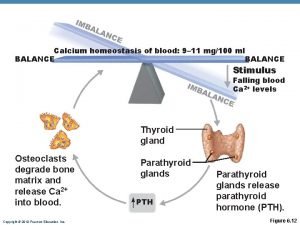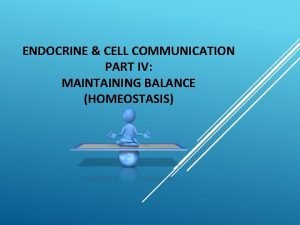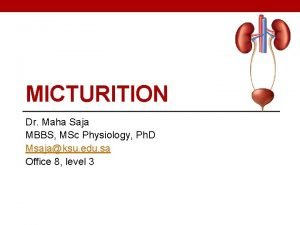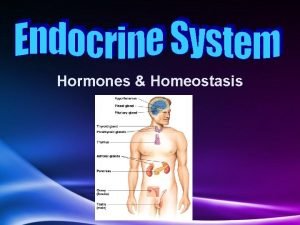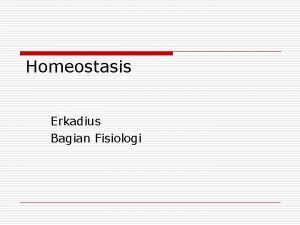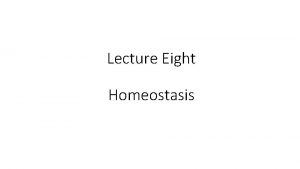Homeostasis Dr Maha Saja Physiology department Level 2























- Slides: 23

Homeostasis Dr. Maha Saja Physiology department, Level 2, Office 89, Email: msaja@ksu. edu. sa

Objectives • Define the concept of the “internal environment” and state its physiologic importance. • Differentiate between the external and internal environments. • Define and discuss the concept of homeostasis and its importance to the living organism. • Discuss the physiologic control mechanisms that enable maintenance of the normal steady state of the body. • Define a feedback mechanism and describe its components. • Differentiate between positive and negative feedback mechanisms and give examples for each in the body. Study source for this lecture: (Guyton & Hall Textbook of Medical Physiology, 13 th ed, Chapter 1)

The Internal Environment “Milieu Intérieur” • All the cells in the body are continuously bathing in fluid. • Because this fluid is outside the cell, it is called extracellular fluid (ECF). • It is from the ECF that cells get the ions and nutrients needed to maintain life. Because, All body cells live in the same environment (i. e. ECF). The composition of ECF is almost similar between the different species. It was named the “internal environment” by the French physiologist Claude Bernard. (Guyton and Hall Textbook of Medical Physiology. 13 th ed. Ch-1)

In order for the cell to function properly, The internal environment need to have the right amount/level of these substances/variables. (not too much and not too little) waste CO 2 Urea Energy (ATP) Chemical reactions Fatty acids Amino acids enzymes p. H Temperature Ions ECF Work Glucose Oxygen (Mr. Ford’s class-Introduction to anatomy and physiology-youtube)

External vs Internal environment • ECF = the internal environment. • The skin separates this environment from the outside world which known as the external environment. 5

External vs Internal environment In Multicellular organisms In Unicellular organisms “External environment” Internal environment = External environment “Internal environment”

External vs Internal environment

Homeostasis • The internal environment must be kept constant in the face of an ever changing external environment. • The internal environment of the body (ECF)is in a dynamic state of equilibrium 8

“Homeostasis” • The process by which the body keeps the internal environment constant despite changes in the external environment is known as “Homeostasis”. • Homeostasis means: – Homeo- : sameness, similarity – -stasis: standing • Essentially all the functions of the body organs and tissues aim at keeping the internal environment at a nearly constant state. (Guyton and Hall Textbook of Medical Physiology. 13 th ed. Ch-1)

Control systems Nervous system O 2 CO 2 Protection Skin Immune system Endocrine systems Internal environment

Body constituents are normally regulated within a range rather than a fixed value;

Control Mechanisms • The body has thousands of control systems. • They function to restore balance when it is lost. • Control systems operate; – Within the organ itself – Throughout the body → to control interrelations between organs. 12

Feedback Mechanisms What is meant by feedback? A loop system in which the system responds to perturbation either in the same direction (positive feedback) or in the opposite direction (negative feedback).

What are the components of a feedback mechanism?

The Thermostat Analogy

Types of Feedback Mechanisms Negative feedback Positive feedback The effector response of the system is in the opposite direction to the stimulus that initiated the response. The effector response is in the same direction of the stimulus that initiated the response. E. g; • A high level of in CO 2 in the ECF will increase pulmonary ventilation, increasing the amount of CO 2 expired which will bring the level of CO 2 in ECF down. E. g; • In nerve signaling, entry of a small amount of Na+ into the cell will open more Na+ channels causing more Na+ to enter the cell. • Most of the control systems of the body act by negative feedback. • Only few systems display positive feedback mechanisms. . WHY?


Examples of Negative Feedback Mechanisms Body temperature control

Blood pressure control

Examples of Positive Feedback Mechanisms Childbirth Can you find other examples for a positive feedback mechanism in the body?

Disease is a state of disturbed homeostasis


 Bioflix activity homeostasis hormones and homeostasis
Bioflix activity homeostasis hormones and homeostasis Bioflix activity homeostasis high blood glucose
Bioflix activity homeostasis high blood glucose Level 3 homeostasis
Level 3 homeostasis Homeostasis blood calcium level (about 10 mg/100ml)
Homeostasis blood calcium level (about 10 mg/100ml) Homeostasis blood calcium level
Homeostasis blood calcium level The maintaining of an internal balance
The maintaining of an internal balance Blood calcium level
Blood calcium level Normal ca level
Normal ca level Mikroanjiopatik hemolitik anemi
Mikroanjiopatik hemolitik anemi Mikroanjiopatik hemolitik anemi nedenleri
Mikroanjiopatik hemolitik anemi nedenleri Maha khachab
Maha khachab Suci suci tuhan maha kuasa
Suci suci tuhan maha kuasa Maha ravana raula
Maha ravana raula Bertakwa kepada tuhan
Bertakwa kepada tuhan Maha teguh dan tegar asmaul husna
Maha teguh dan tegar asmaul husna District 6 maha
District 6 maha Al bashir artinya allah maha
Al bashir artinya allah maha Shelterdness
Shelterdness Allah maha ikhlas
Allah maha ikhlas Katakanlah dialah
Katakanlah dialah Kailā maha
Kailā maha Dr kathryn boyd
Dr kathryn boyd Maha el keshawi
Maha el keshawi Maha ka matlab
Maha ka matlab



